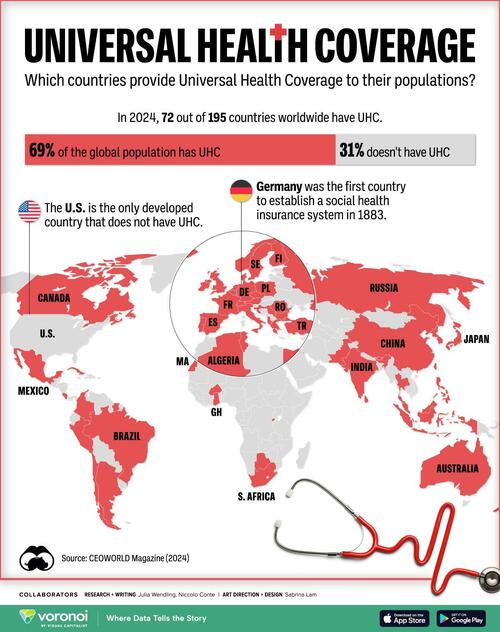Which Countries Have Universal Health Coverage?
According to the World Health Organization (WHO), Universal Health Coverage (UHC) means that everyone has access to a full range of health services - from emergency interventions to palliative care - without financial difficulty.
In this graphic, Visual Capitalist's Julia Wendling uses data from CEOWorld Magazine to visualize the countries that have UHC versus those that do not, along with how UHC coverage breaks down in terms of the global population.
The State of Universal Health Coverage in the World
In 2024, 73 of the 195 countries worldwide had UHC, resulting in around 69% of the world’s population having some form of universal healthcare.
| Country | UHC? |
|---|---|
| Albania 🇦🇱 | Yes |
| Algeria 🇩🇿 | Yes |
| Argentina 🇦🇷 | Yes |
| Australia 🇦🇺 | Yes |
| Austria 🇦🇹 | Yes |
| Bahamas 🇧🇸 | Yes |
| Belgium 🇧🇪 | Yes |
| Bhutan 🇧🇹 | Yes |
| Botswana 🇧🇼 | Yes |
| Brazil 🇧🇷 | Yes |
| Bulgaria 🇧🇬 | Yes |
| Burkina Faso 🇧🇫 | Yes |
| Canada 🇨🇦 | Yes |
| Chile 🇨🇱 | Yes |
| China 🇨🇳 | Yes |
| Colombia 🇨🇴 | Yes |
| Costa Rica 🇨🇷 | Yes |
| Croatia 🇭🇷 | Yes |
| Cuba 🇨🇺 | Yes |
| Czech Republic 🇨🇿 | Yes |
| Denmark 🇩🇰 | Yes |
| Egypt 🇪🇬 | Yes |
| Finland 🇫🇮 | Yes |
| France 🇫🇷 | Yes |
| Georgia 🇬🇪 | Yes |
| Germany 🇩🇪 | Yes |
| Ghana 🇬🇭 | Yes |
| Greece 🇬🇷 | Yes |
| Hong Kong 🇭🇰 | Yes |
| Iceland 🇮🇸 | Yes |
| India 🇮🇳 | Yes |
| Indonesia 🇮🇩 | Yes |
| Ireland 🇮🇪 | Yes |
| Israel 🇮🇱 | Yes |
| Italy 🇮🇹 | Yes |
| Japan 🇯🇵 | Yes |
| Kuwait 🇰🇼 | Yes |
| Liechtenstein 🇱🇮 | Yes |
| Luxembourg 🇱🇺 | Yes |
| Macau 🇲🇴 | Yes |
| Malaysia 🇲🇾 | Yes |
| Maldives 🇲🇻 | Yes |
| Mauritius 🇲🇺 | Yes |
| Mexico 🇲🇽 | Yes |
| Morocco 🇲🇦 | Yes |
| Netherlands 🇳🇱 | Yes |
| New Zealand 🇳🇿 | Yes |
| North Korea 🇰🇵 | Yes |
| Norway 🇳🇴 | Yes |
| Pakistan 🇵🇰 | Yes |
| Peru 🇵🇪 | Yes |
| Philippines 🇵🇭 | Yes |
| Poland 🇵🇱 | Yes |
| Portugal 🇵🇹 | Yes |
| Romania 🇷🇴 | Yes |
| Russia 🇷🇺 | Yes |
| Rwanda 🇷🇼 | Yes |
| Serbia 🇷🇸 | Yes |
| Seychelles 🇸🇨 | Yes |
| Singapore 🇸🇬 | Yes |
| South Africa 🇿🇦 | Yes |
| South Korea 🇰🇷 | Yes |
| Spain 🇪🇸 | Yes |
| Sri Lanka 🇱🇰 | Yes |
| Suriname 🇸🇷 | Yes |
| Sweden 🇸🇪 | Yes |
| Switzerland 🇨🇭 | Yes |
| Taiwan 🇹🇼 | Yes |
| Thailand 🇹🇭 | Yes |
| Trinidad and Tobago 🇹🇹 | Yes |
| Tunisia 🇹🇳 | Yes |
| Turkey 🇹🇷 | Yes |
| United Kingdom 🇬🇧 | Yes |
The United States is the only developed country without health coverage for all of its citizens.
As of 2022, the Census Bureau estimated that only 36.1% of Americans were covered by public health insurance. Private health insurance covered 65.6% of the population. This along with other facts has led the U.S. having the world’s highest healthcare spending figure per capita.
The History of Public Health Coverage
Germany was the first country to establish a social health insurance system. Launched in 1883, the program began by covering only blue-collar workers, then slowly expanded its net of those covered.
The first international declaration underlying the need for adequate health care was the Declaration of Alma-Ata in 1978 at the International Conference on Primary Health Care in 1978. The conference’s target was to achieve global UHC by 2000.
The Ottawa Charter for Health Promotion of 1986 also reiterated the “Health for All by the year 2000” goal, ultimately paving the way for more countries to adopt UHC.



